|
|
|
Sort Order |
|
|
|
Items / Page
|
|
|
|
|
|
|
| Srl | Item |
| 1 |
ID:
181188
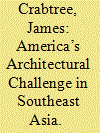

|
|
|
|
|
| Summary/Abstract |
US Vice President Kamala Harris and Secretary of Defense Lloyd J. Austin III have made significant official visits to Southeast Asia. Both sought to address concerns that the US had paid insufficient attention to the region during President Joe Biden's early months in office. But they left unanswered substantial questions about future US strategy as to both the Asia-Pacific as a whole and Southeast Asia in particular. This underlined doubts about Washington's ability to create and develop the kind of regional initiatives, institutions and partnerships that might help to blunt China's rise and draw nations in Southeast Asia back towards the US. To do so, the US will have to marshal deep focus and subtle statecraft to create new diplomatic architecture and set new standards for the region in areas such as trade and new technologies. Otherwise, American influence in the region is likely to decline.
|
|
|
|
|
|
|
|
|
|
|
|
|
|
|
|
| 2 |
ID:
180758
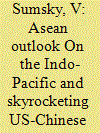

|
|
|
|
|
| Summary/Abstract |
For more than 10 years before that, the idea of the Indo-Pacific as a new regional configuration in the area of the Indian and Pacific Oceans to replace the Asia-Pacific Region construct had been bounced around at various international expert forums and in government circles of some countries, primarily the United States, Japan, Australia, and India. In 2007-2008, those four countries, which are more or less openly seeking to contain the growing economic and naval might of China, tried to create a quadrilateral group. They failed to establish any steady cooperation at that time, and for about the next 10 years, each of them sought to develop its own concept for a new regional formation while regularly attempting to coordinate positions with the other three in unofficial meetings on Indo-Pacific issues.
|
|
|
|
|
|
|
|
|
|
|
|
|
|
|
|
| 3 |
ID:
187213
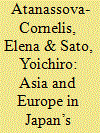

|
|
|
|
|
| Summary/Abstract |
This article examines Japan’s security alignments with key Asian and European partners, notably Australia, India, the UK, France and the EU itself. The articles explores Tokyo’s strategic expectations with regard to each of the five partnerships, as well as probing the likely future evolution of these alignments by providing a comparative perspective. Japan’s alignments with Australia and India conform with and supplement the US-Japan alliance, addressing Japan’s primary geostrategic concerns in the Asia-Pacific and the Indian Ocean region. Tokyo’s security partnerships with the European partners, and the EU, are more recent and not rooted in any US-led alliance in Asia. The degree of traditional kinetic military power these European players can bring to Asia is very limited. However, the pace with which Japan’s new European alignments are quickly moving beyond the non-traditional security areas to encompass more traditional defence and military-security fields attests to their potential of evolving in the future into mechanisms able to perform a broad range of security functions in response to complex security threats. The boundaries between these two categories of partnerships are likely to be further blurred, providing Japan with various mechanisms at different levels to shape and influence the regional and global security environment.
|
|
|
|
|
|
|
|
|
|
|
|
|
|
|
|
| 4 |
ID:
172564
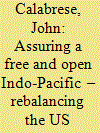

|
|
|
|
|
| Summary/Abstract |
Borrowing the term ‘Indo-Pacific’ from Japanese Prime Minister Shinzo Abe and refashioning the Obama ‘Pivot to Asia’ or ‘Rebalance Strategy’, the Trump administration has articulated a vision of a Free and Open Indo-Pacific (FOIP), which, as its public discourse and official documents reveal, is defined through the lens of great power competition with China. Since the latter part of 2017, the administration has laid the groundwork for a whole-of-government approach aimed at advancing this vision, which consists of three pillars: economy, governance, and security. Southeast Asia – a dynamic sub-region and the fulcrum of the wider Indo-Pacific – is central to the evolving US strategy. However, in its current form, that strategy casts China in the role of an existential threat and economic enemy, and seems overly focused on military security. For these reasons, it is unlikely to garner the full support of allies and partners – without which shared prosperity, good governance, and a peaceful and secure regional order across the Indo-Pacific cannot be assured. A repositioning and repurposing of the recently resuscitated Quadrilateral Security Dialogue (or Quad) could transform this minilateral platform into a useful instrument to coordinate the four members' actions, leverage the capabilities of Quad-Plus countries, and engage ASEAN in managing non-traditional security challenges and furthering its connectivity agenda.
|
|
|
|
|
|
|
|
|
|
|
|
|
|
|
|
| 5 |
ID:
181708
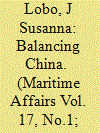

|
|
|
|
|
| Summary/Abstract |
The Indo-Pacific has emerged as an important region in international politics where the major powers are deeply engaged in reshaping the security architecture. Over the last few years, India and China have drawn their policies by employing competitive strategies that strengthen as well as neutralise their respective power positions in the Indian Ocean Region, particularly in South Asia and the South China Sea. China's “String of Pearls” strategy and the “Belt and Road Initiative” undermine India's influence in the Indian Ocean Region, where the changing geo-economic and geostrategic imperatives pose threat to its interests. This mounts pressure on New Delhi to respond by pursuing counter-strategies to secure its interests in the Indo-Pacific region. The article further explains how India and the United States’ interests are converging against an assertive China in the Indo-Pacific and how the two states’ security and maritime collaborations are balancing their common rival by maintaining a favourable status quo in the region.
|
|
|
|
|
|
|
|
|
|
|
|
|
|
|
|
| 6 |
ID:
192514
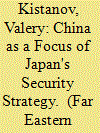

|
|
|
|
|
| Summary/Abstract |
This paper deals with Japan's current security policy toward China. Both countries have now become major trade and economic partners, but at the same time, their political ties have deteriorated significantly. Over the past decade, the degree of conflict in Japanese-Chinese relations has increased dramatically, despite consistent efforts by Tokyo and Beijing to improve bilateral ties through political and diplomatic measures. Japan is increasingly concerned about China's offensive naval activities in the East and South China Seas, which Tokyo regards as an area of vital interest. The most acute points of confrontation today are the situations around the Senkaku Islands and Taiwan, which could escalate into armed clashes. With the adoption of Tokyo's new National Security Strategy in December 2022, China has in effect been elevated to the main military threat to Japan. Under this strategy, Tokyo has embarked on a course of strengthening its military capabilities, paying particular attention to their offensive component. Moreover, in preparation for responding to the "Chinese threat," Japan is taking measures to qualitatively and quantitatively strengthen military cooperation with the US under a security treaty. The military alliance with the US will remain the cornerstone of Japan's security for the foreseeable future, including with the aim of deterring an increasingly powerful China.
|
|
|
|
|
|
|
|
|
|
|
|
|
|
|
|
| 7 |
ID:
186800
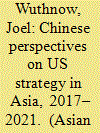

|
|
|
|
|
| Summary/Abstract |
The architects of US strategy in Asia have advanced a bold vision for a "free and open Indo-Pacific" but have paid less attention to China's views and responses. This article surveys perceptions of Chinese strategists toward the Trump administration's regional approach, arguing that China's analytic community came to see US strategy as largely focused on the Quadrilateral Security Dialogue. The most frequent Chinese prescription was a wedge strategy to weaken support for the United States among the other three Quad states: Japan, India, and Australia. Evidence from Chinese public diplomacy during the Trump years is consistent with such an approach. Yet the increase in assertive actions targeting the Quad partners revealed other impulses guiding policymakers and ultimately brought the four states more closely together. The Biden administration has an opportunity to leverage China's inability to successfully execute a wedge strategy to strengthen support for US influence and goals in the region.
|
|
|
|
|
|
|
|
|
|
|
|
|
|
|
|
| 8 |
ID:
181695
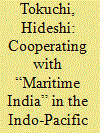

|
|
|
|
|
| Summary/Abstract |
The main purpose of this article is to identify a common basis for Japan and India as maritime democracies to work together for the maintenance and enhancement of the rules-based liberal international order at sea in the face of a variety of challenges in the Indo-Pacific region, China’s maritime advancement in particular. As powerful maritime democracies in the Indo-Pacific, Japan and India will be able to engage in a wide variety of maritime security cooperation. The opinions of security experts of both countries should be mustered so that bilateral cooperation keeps up its momentum. Synergy of Tracks 1, 1.5 and 2 dialogues should be pursued for maritime security cooperation. In this bilateral effort, the US-centred alliance network, of which the Japan-US Alliance is the central portion, and India’s autonomous and multi-directional approach toward international security must be intertwined effectively. Also, security dialogues between the two countries and between the two navies should work out the division of labour between Japan and India to contribute to the Indo-Pacific regional maritime security more effectively.
|
|
|
|
|
|
|
|
|
|
|
|
|
|
|
|
| 9 |
ID:
174959
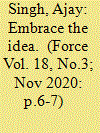

|
|
|
| 10 |
ID:
192703


|
|
|
|
|
| Publication |
New Delhi, Sabre and Quill Publishers, 2024.
|
| Description |
216p.hbk
|
| Standard Number |
9788119509539
|
|
|
|
|
|
|
|
|
|
|
|
Copies: C:1/I:0,R:0,Q:0
Circulation
| Accession# | Call# | Current Location | Status | Policy | Location |
| 060477 | 327/SRI 060477 | Main | On Shelf | General | |
|
|
|
|
| 11 |
ID:
189250
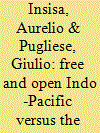

|
|
|
|
|
| Summary/Abstract |
Recent scholarship suggests that the thawing of diplomatic relations between China and Japan has caused a readjustment of Beijing’s Belt and Road Initiative and Tokyo’s Free and Open Indo-Pacific Vision towards an emerging complementarity. Through careful process-tracking, elite interviews, and analysis of Chinese and Japanese primary sources, this article instead demonstrates how, outside of the East Asian spotlight, Sino-Japanese geo-economic competition continues in South Asia and the Mekong subregion, fueled by power politics and a mutual distrust of each other’s initiatives. On the basis of this evidence, this article qualifies Sino-Japanese interactions as a quest and denial for spheres of influence, whereas the Japanese government aims at denying Chinese spheres of influence. In doing so, this article highlights how Japanese proactivism from Sri Lanka to Thailand, via infrastructure and government financing, has become a driver of growing non-traditional security cooperation with India, the U.S., and Australia.
|
|
|
|
|
|
|
|
|
|
|
|
|
|
|
|
| 12 |
ID:
184983


|
|
|
|
|
| Summary/Abstract |
In 2022, India captured global attention over its response to the war in Ukraine. While calling for both parties’ return to diplomacy, India abstained from several United Nations resolutions condemning Russian aggression. For a country that ostensibly subscribes to the values of democracy and territorial integrity, its response appeared frustrating and contradictory, but it is broadly consistent with its long-standing policy of non-alignment. Although India’s relationship with China is increasingly contentious, New Delhi is not yet fully convinced that it is in India’s interest to swing westwards. The country’s relations with Russia and China are deep, complex and substantive. In addition to the military and economic benefits it derives from its connection with Russia, New Delhi and Moscow share an avowed preference for a more equal, multipolar world. India will eventually have to reflect on the extent to which it can sustain its balancing act.
|
|
|
|
|
|
|
|
|
|
|
|
|
|
|
|
| 13 |
ID:
190668
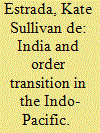

|
|
|
|
|
| Summary/Abstract |
Managing order transition in the Indo-Pacific is as much about negotiating the character of regional order as it is about mounting balance of power challenges or establishing countervailing institutional arrangements. For this reason, members of the Quad have expressed ambitions to deliver shared security on the basis of collective identity and values—though at times more in discourse than in practice. This article argues that India is actively contesting and, in some ways reconfiguring, the legitimating narratives of the Quad as an Indo-Pacific ‘security community’. Under the leadership of Narendra Modi, India has approached the socialising imperative of liberal identity cues selectively and ambivalently. More widely, India has declined to pursue an overt, collective strategy of Chinese containment and has propounded distinctive visions of regional security provision. India’s vision for liberal order in the Indo-Pacific stands apart from the ‘security community’ that the other Quad partners have enunciated in their foreign policy discourse, with consequences for the future of order transition in the Indo-Pacific.
|
|
|
|
|
|
|
|
|
|
|
|
|
|
|
|
| 14 |
ID:
180080
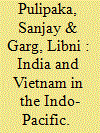

|
|
|
|
|
| Summary/Abstract |
The international order today is characterised by power shift and increasing multipolarity. Countries such as India and Vietnam are working to consolidate the evolving multipolarity in the Indo-Pacific. The article maps the convergences in the Indian and Vietnamese foreign policy strategies and in their approaches to the Indo-Pacific. Both countries confront similar security challenges, such as creeping territorial aggression. Further, India and Vietnam are collaborating with the United States and Japan to maintain a favourable balance of power in the Indo-Pacific. While Delhi and Hanoi agree on the need to reform the United Nations, there is still some distance to travel to find a common position on regional economic architectures. The India–Vietnam partnership demonstrates that nation-states will seek to define the structure of the international order and in this instance by increasing the intensity of multipolarity.
|
|
|
|
|
|
|
|
|
|
|
|
|
|
|
|
| 15 |
ID:
181480
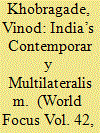

|
|
|
| 16 |
ID:
187140
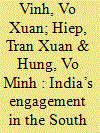

|
|
|
|
|
| Summary/Abstract |
The South China Sea is of immense strategic significance to India from politico-diplomatic, economic and security perspectives. As a rising power, India has expanded its strategic geography and, in this context, it formulated its Look East Policy, which was rechristened as the Act East Policy in 2014. Its current interests go beyond Southeast Asia into the wider Asia-Pacific region, including the South China Sea. From an economic perspective, more than 50% of India’s trade is transported through the sea lanes of the South China Sea. India is also concerned about China’s assertiveness here, in particular its aggressive posturing and militarisation of the disputed Spratly and Paracel Islands and non-adherence to the 1982 United Nations Convention on the Law of the Sea (UNCLOS). India has actively promoted the principles of international law and freedom of navigation and overflight in the South China Sea. Further, the Indian Navy has maintained a regular presence in the South China Sea to protect India’s economic and security interests, which includes the Oil and Natural Gas Corporation’s (ONGC) offshore oil and gas exploration project in partnership with Vietnam.
|
|
|
|
|
|
|
|
|
|
|
|
|
|
|
|
| 17 |
ID:
189173
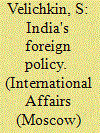

|
|
|
|
|
| Summary/Abstract |
INDIA traditionally sets high expectations for its diplomacy. This is to be expected in the country of Chanakya and Jawaharlal Nehru, and it is very encouraging. After all, throughout its 75 years of independence, India has been a significant actor in world affairs, supporting peace and cooperation. To Russia, India is a friend with whom there have never been quarrels, many of our key interests overlap, and significant mutual understanding has been achieved.
|
|
|
|
|
|
|
|
|
|
|
|
|
|
|
|
| 18 |
ID:
185651
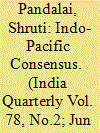

|
|
|
|
|
| Summary/Abstract |
The view that the concept of the Indo-Pacific is not new nor an aberration has anchored New Delhi’s embrace of this geopolitical reality and the articulation of its central role and vision for this dynamic theatre. This revisiting of history has happened, in New Delhi’s understanding, because of drivers such as globalisation, multipolarity and a recognition by the United States that it needs to work with others to manage the disruptive rise of China, among other global challenges. India has always considered itself an Indo-Pacific actor, given its geographical location, its interests and stakes primarily in the Indian Ocean and increasingly in the pacific, its bilateral partnerships which then see a shared interest in the region, its presence in existent Indo-Pacific bodies spanning the two oceans and its growing role as a provider of net security and preferred maritime security partner for many countries in the Indo-Pacific. This article traces the evolution of the Indo-Pacific in New Delhi’s strategic calculus and its pre-eminence as a theatre of geo-strategic and geo-economic opportunity. It argues that three trends have emerged as distinguishable features, which serve as building blocks of cooperation in the Indo-Pacific today, especially for India: (a) issue-based coalitions driven by function, where flexibility of these configurations remains a strategic asset, (b) like-minded countries working together in overlapping bilateral, minilateral and plurilateral formats to expand global initiatives in a way that they are institutionalised within the national agendas of regional like-minded powers and (c) a focused effort on building capacity of countries in the Indo-Pacific to give them viable alternatives which go beyond binaries formed around ideological and political contestation. Post COVID-19, consolidating the India way in the Indo-Pacific will depend on how India strengthens its domestic capacity and shapes geopolitics at the regional and global levels.
|
|
|
|
|
|
|
|
|
|
|
|
|
|
|
|
| 19 |
ID:
188451
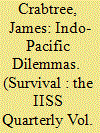

|
|
|
|
|
| Summary/Abstract |
The United States intends to manage China’s rise by forging a new balancing coalition of ‘like-minded’ partners and by developing deeper ties with other nations in the Indo-Pacific that view themselves as broadly non-aligned. Washington hopes that closer ties to the US and its partners will stop such countries from drifting towards China. But to create these deeper relationships, the non-aligned group also needs reassurance that attempts by the like-minded partners to integrate capabilities and fashion a new regional balance of power will not tip the Indo-Pacific towards conflict. Like-minded nations will need to appreciate the risks that security initiatives like the Quad and AUKUS are perceived to create, realise that Hanoi or Jakarta is unlikely to embrace Canberra’s or Tokyo’s vision of the region’s future warmly, and be willing to make substantial material investments. Tension between integration and reassurance will inevitably endure.
|
|
|
|
|
|
|
|
|
|
|
|
|
|
|
|
| 20 |
ID:
190072
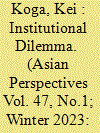

|
|
|
|
|
| Summary/Abstract |
How is the future of the Indo-Pacific institutional arrangements envisioned by the Quad and ASEAN? Are they mutually exclusive or compatible? How can the institutional competition between the Quad and ASEAN in the Indo-Pacific be avoided? I argue that the institutional competition between the Quad and ASEAN can be provisionally alleviated through strategic ambiguities about the institutional division of labor in the Indo-Pacific. However, such strategic ambiguities do not resolve normative inconsistencies between the Quad and ASEAN, which would probably trigger institutional competition in the future. To resolve such difficulties, both the Quad and ASEAN need to create a mechanism that clarifies their regional institutional division of labor.
|
|
|
|
|
|
|
|
|
|
|
|
|
|
|
|
|
|
|
|
|